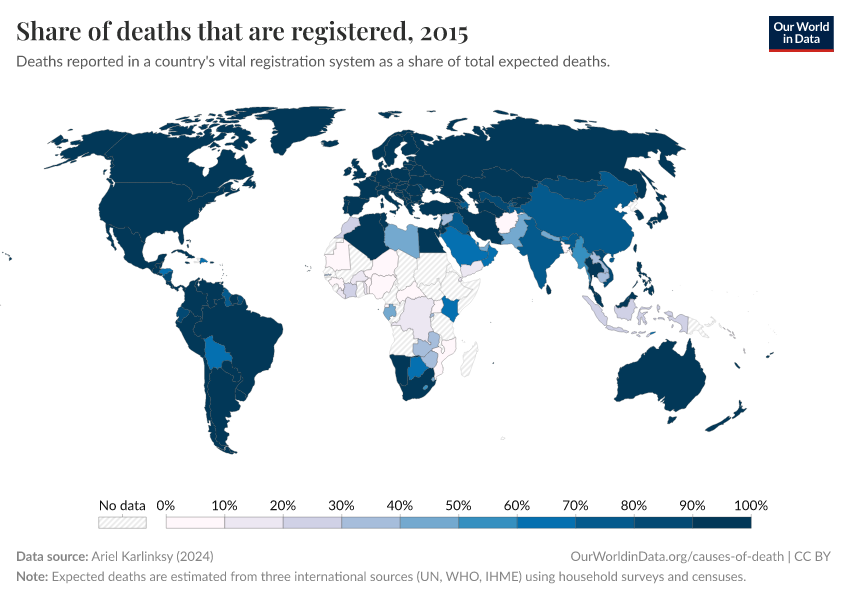Share of deaths that are registered

What you should know about this indicator
- The most common way of knowing how many deaths occur in a country is to rely on death certificates registered in national Vital Registry systems. In many countries, however, a large share of deaths are not registered. This is due to factors such as a lack of doctors and nurses to fill in death certificates, or a poorly functioning Vital Registry system.
- This indicator estimates the extent of under-registering, given as the share of deaths that were registered, out of the total deaths expected for that year.
- The number of expected deaths is estimated by taking the average number of deaths from three data sources: the UN's World Population Prospects, WHO's Global Health Estimates and IHME's Global Burden of Disease study. These three sources themselves estimate the number of deaths from models based on data from censuses and household surveys. For many countries, the estimates of the three sources are very similar. However, for others, where vital registration systems are lacking or not functional, they tend to differ.
Related research and writing
What you should know about this indicator
- The most common way of knowing how many deaths occur in a country is to rely on death certificates registered in national Vital Registry systems. In many countries, however, a large share of deaths are not registered. This is due to factors such as a lack of doctors and nurses to fill in death certificates, or a poorly functioning Vital Registry system.
- This indicator estimates the extent of under-registering, given as the share of deaths that were registered, out of the total deaths expected for that year.
- The number of expected deaths is estimated by taking the average number of deaths from three data sources: the UN's World Population Prospects, WHO's Global Health Estimates and IHME's Global Burden of Disease study. These three sources themselves estimate the number of deaths from models based on data from censuses and household surveys. For many countries, the estimates of the three sources are very similar. However, for others, where vital registration systems are lacking or not functional, they tend to differ.
Frequently Asked Questions
How are the expected deaths per year estimated?
The total number of deaths expected each year can be estimated using data from censuses, surveys and other data sources about the size of the population by age, sex and other demographics. For example, they can be estimated using historical trends and registered deaths. In addition, countries carry out censuses, usually around every ten years.
Researchers can compare people in one census and the next, and look at their year of birth, to estimate how many people in that birth cohort died in between censuses. This can help project the number of deaths each year by age and other demographics.
Different groups use slightly different methods to estimate the total number of expected deaths each year, but their estimates are mostly similar. Estimates vary more widely for countries with poorly functioning Vital Registries. This dataset by Ariel Karlinsky uses an average of estimates from three sources: the UN's World Population Prospects, WHO's Global Health Estimates and IHME's Global Burden of Disease study.
Sources and processing
This data is based on the following sources
How we process data at Our World in Data
All data and visualizations on Our World in Data rely on data sourced from one or several original data providers. Preparing this original data involves several processing steps. Depending on the data, this can include standardizing country names and world region definitions, converting units, calculating derived indicators such as per capita measures, as well as adding or adapting metadata such as the name or the description given to an indicator.
At the link below you can find a detailed description of the structure of our data pipeline, including links to all the code used to prepare data across Our World in Data.
Reuse this work
- All data produced by third-party providers and made available by Our World in Data are subject to the license terms from the original providers. Our work would not be possible without the data providers we rely on, so we ask you to always cite them appropriately (see below). This is crucial to allow data providers to continue doing their work, enhancing, maintaining and updating valuable data.
- All data, visualizations, and code produced by Our World in Data are completely open access under the Creative Commons BY license. You have the permission to use, distribute, and reproduce these in any medium, provided the source and authors are credited.
Citations
How to cite this page
To cite this page overall, including any descriptions, FAQs or explanations of the data authored by Our World in Data, please use the following citation:
“Data Page: Share of deaths that are registered”, part of the following publication: Saloni Dattani, Fiona Spooner, Hannah Ritchie, and Max Roser (2023) - “Causes of Death”. Data adapted from Ariel Karlinksy. Retrieved from https://archive.ourworldindata.org/20250909-093708/grapher/share-of-deaths-registered.html [online resource] (archived on September 9, 2025).How to cite this data
In-line citationIf you have limited space (e.g. in data visualizations), you can use this abbreviated in-line citation:
Ariel Karlinksy (2024) – processed by Our World in DataFull citation
Ariel Karlinksy (2024) – processed by Our World in Data. “Share of deaths that are registered – Ariel Karlinsky (2024)” [dataset]. Ariel Karlinksy, “International Completeness of Death Registration 2015-2019” [original data]. Retrieved December 6, 2025 from https://archive.ourworldindata.org/20250909-093708/grapher/share-of-deaths-registered.html (archived on September 9, 2025).